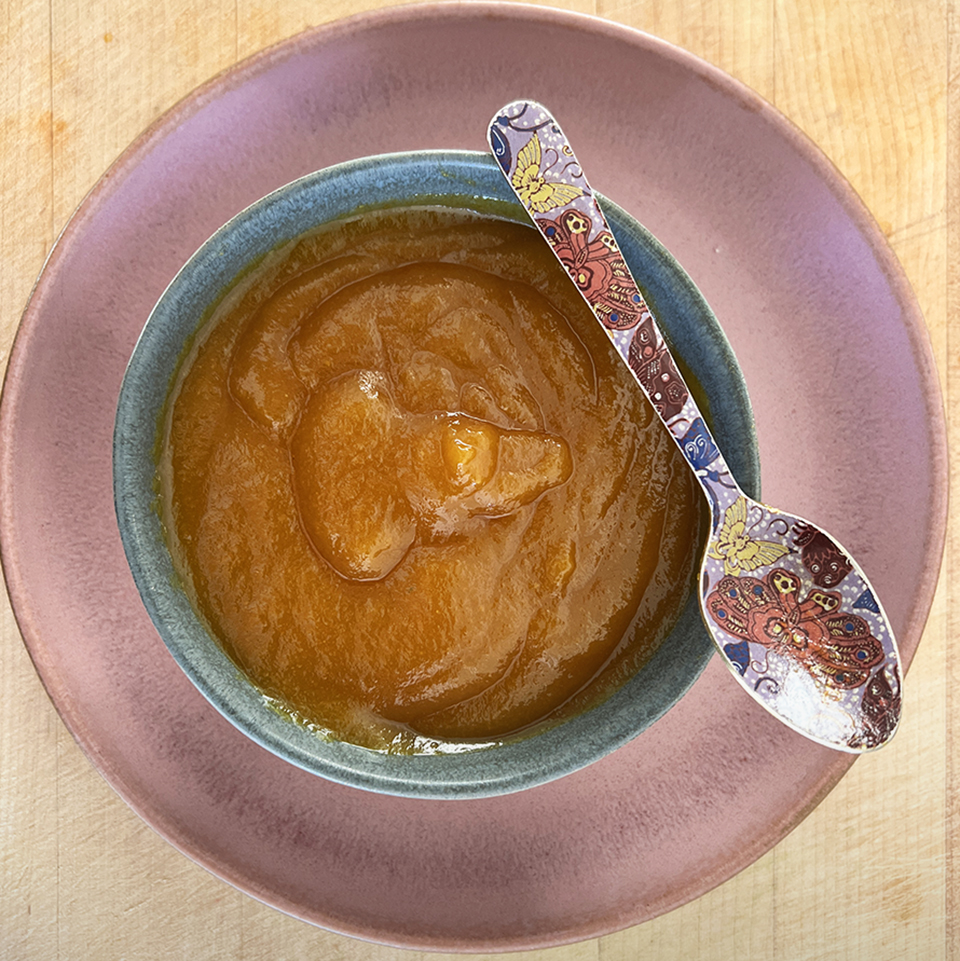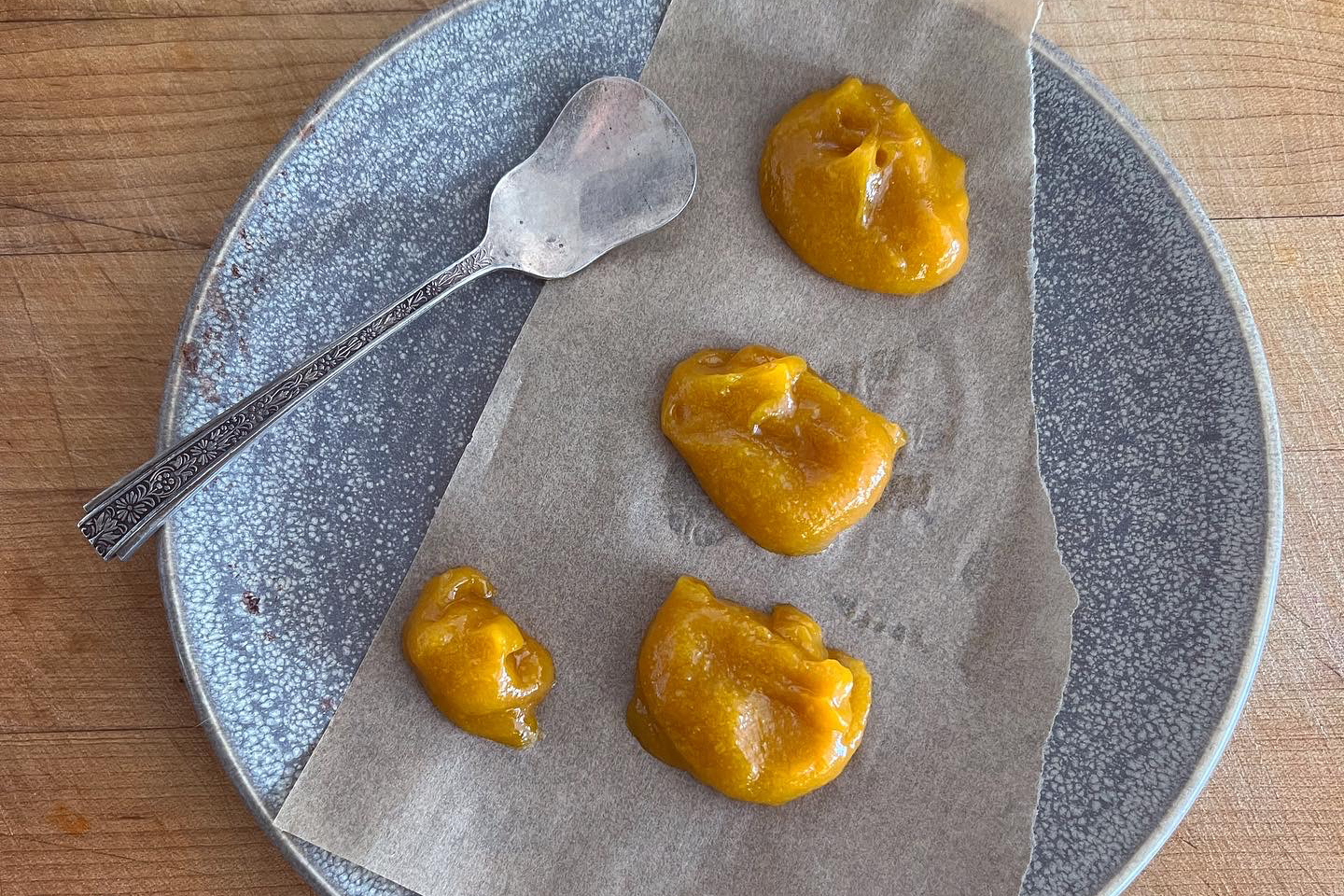Mango dulce de Leche, made with mangoes, made into flan
Several years ago, under pressure to create new Halloween recipes, I had the brilliant idea (a hypothesis at the time) to make caramel using nothing but mangoes. Since mangoes contain significant natural sugar, why wouldn’t they, in pureed form, caramelize like sugar and water do when heated at a high temperature? Well, they do, and I was right. That fall, “Mango Caramel 3 Ways” was born.
During those fall explorations I created 3 unique caramel recipes, all utilizing mango puree as the base or main ingredient – Salted Mango Caramel, with butter, cream and salt, Faux Mango Caramel– which is technically a vegan sugar-free caramel and one of the healthiest options for caramel lovers, and a Tropical Vegan Mango Dulce de Leche, my twist on the oven made hack that uses a can of sweetened condensed milk and a hot oven to make dulce de leche.
This fall I have new mango caramel recipe for authentic dulce de leche, the one I left out on my original mango caramel experiments. I left it out partly because it proved to be the most challenging in terms of achieving a result that captures the essence and texture of true dulce de leche. After tinkering with various ideas over the years I finally, with a little encouragement from Mango Hunter Jeff Ray, figured out how to bring it to life.
Dulce de leche is one of Latin America’s most popular sweet treats. This “candy milk”, its literal translation, is made by slowly cooking down milk and sugar until it thickens and caramelizes, in a creamy thick concoction, taking on a rich caramel, toffee-like flavor and amber color.
There are various theories regarding the history and origin of dulce de leche, with most tracing its roots directly to Latin America. Many historians suggest that the concept of sweetened milk products existed in the Americas prior to the arrival of the conquistadors. Indigenous peoples throughout the region not only consumed milk products but also incorporated them into their culinary practices. They crafted sweet treats using honey, fruit, and even corn-based sweeteners, reminiscent of chancaca, which is a South American form of caramel made from boiling down sugar cane juice.
The Spanish also had a similar caramelized milk and sugar product in their own culinary tradition, which they brought with them to the Americas. They introduced not only sugar into the mix, but also various new culinary techniques. Most historians believe that the dulce de leche we know today is a biproduct of this dynamic culinary cultural exchange, a fusion of both indigenous and European influences.
What is absolutely true is that dulce de leche is beloved and iconic throughout Latin America today. Each country and region adds its own unique twists and variations to recipes and uses, in this highly versatile sweet. In Latin America, it’s commonly spread on bread, tortillas, or toast. It’s also used as a filling for pastries, cakes, and cookies, or as a topping for ice cream or pancakes. It’s widely used as a flavoring in coffee and other beverages. The sweet, caramelized taste of dulce de leche is reflected in numerous Latin American and South American desserts. Whether it’s Argentina’s famous Alfajores (dulce de leche sandwich cookies), a simple tres leches cake, or a creamy flan, dulce de leche (or any other name it goes by) and its influence are potent throughout Latin America.
This beloved toffee-like treat goes by various names across Latin America. In Brazil, it’s simply called ‘doce de leite,’ while in Peru, it’s known as ‘leche condensada.’ In Chile, Costa Rica, and Ecuador, it’s referred to as “manjar.” Argentina affectionately calls it ‘dulce de leche,’ and in Mexico, where it’s commonly made with goat’s milk, the version is called ‘cajeta.’ Each region imparts its own unique twist to this delectable creation. Puerto Rico is known for incorporating coconut milk into their version, while El Salvador and some Caribbean islands have a variations cooked longer, resulting in thick, pliable versions of in El Salvador’s case, almost brittle like. The world of dulce de leche is diverse, thick and others thin, some flavored with regional and local spices, and some featuring fruits, all versions together creating a rich tapestry of sweet tastes.
My mango take on dulce de leche utilizes mangoes as a unique source of sugar, resulting in the use of way less processed sugar, but still plenty of caramelization needed to make a rich caramel like dulce de leche. The warming tones of cooked mangoes, that meld with the creamy nature of the milk, not only align to create and extremely traditional tasting version, but one with a slight and pleasant mango flavor that sets it apart.
I have been working on this recipe for a few years now, trying to get it just right. The problem is that not all mangoes are created equal. They vary in water content, fiber, and sugar levels, which can impact the consistency of the final sauce/spread. Unlike my standard mango caramel recipes, where water and mango puree is cooked down and the outcome more predictable, the introduction of milk proved challenging. The science did and still does, confuse me a bit. I tried to achieve this recipe’s success without adding sugar but in the end found that some sugar is needed for the milk and mango to caramelize quicker without separating.
The inclusion of baking soda, a trick I learned while refining my Whiskey Truffle Caramel recipe for a magazine article and food event I did, I think plays a pivotal role. Baking soda not only aids the caramelization process, which becomes more critical when primarily relying on mango puree instead of sugar, but it also ensures a smoother interaction between the milk proteins and the mango, resulting in a cohesive blend as they caramelize.
The exact science behind this transformative process might be a bit complex, often referred to as the Maillard Reaction, and I admit, sometimes (most times) I am confused by it, but what I can affirm is the magic it brings to this culinary experiment, to my experience with cooking mangoes and coaxing out some of the most unexpected deeply warming notes and flavors. There’s a Serious Eats article that discusses the Mailliard Reaction in the contest of steak and the specific and amazing flavor that can be produced with specific heat. My deepest visceral understanding of the Maillard Reaction is rooted in cooking with caramelizing mangoes and the truly magical flavors that appear in that same process as with the steak. The flavors mangoes produce when cooked are extremely unique and not what you would expect from a tropical fruit, this dulce de leche recipe, demonstrates this sentiment and will truly blow your mind, mango caramel (now 4 ways) will.
Mango Dulce De Leche
Makes about 1 cup
Unlike my other sugar-free mango recipes that rely solely on the natural sugars found in mangoes, this one incorporates a small amount of added sugar. The inclusion of sugar somewhat ensures the desired final texture is true to dulce de leche. You can choose to omit it, and for the most part, it still works, but occasionally, a grittier texture may emerge due to the varying/unpredictable water content in mangoes that seems to cause more seprate in the milk and mango solids.
But rest assured, it’s the natural sweetness of ripe mangoes that forms the main sugar backdrop for this mango dulce de leche. It cooks down sweet ripe mangoes and milk into the creamiest, dreamiest, and most luxuriously rich treat, infused with the warm, earthy notes of cooked mango sugars. Use this just as they do in Latin America—dolloped on, spread across, interwoven in… everything.
Ingredients
2 ½ cups chopped mango
2 cups whole milk
½ cup sugar
½ teaspoon baking soda
1 ½ teaspoons vanilla
Method
Combine the chopped mango, whole milk, and sugar in a blender and blend until completely smooth. Pour the mixture into a heavy-bottomed saucepan and bring it to a boil. Stir in the vanilla and baking soda, then reduce the heat. Let simmer uncovered, stirring occasionally, for about an hour. As it simmers, the mixture will gradually darken into a more caramel color, and the edges of the pan will develop a thin, cooked coating of mango solids.
At this point, stir more frequently to prevent burning and to ensure that the solids and liquids, that want to separate, cook conjunctly. Cook, while stirring often, for approximately another half hour, or until you achieve the desired dulce de leche consistency.
Transfer the mango dulce de leche to a bowl and allow it to cool. Keeps well refrigerated for up to 4 weeks.
Spiced Mango Dulce De Leche Flan with Nixta Licor de Elote Caramel
Serves 6
Flan’s origins can be traced back to an ancient Roman dish known as “flado,” which emerged during a surplus of eggs, leading to the creation of savory custard dishes, typically characterized by their flat nature. The Spaniards, through their advancements in sugar processing, introduced caramelization techniques. Throughout the era of the conquistadores, flan continued to evolve, incorporating new ingredients, cooking methods, and cultural influences.
In Latin America, flan transformed into the delicacy we recognize today – a sweet, flat custard covered in caramel, made with milk, eggs, and sweetener. It is often baked in a water bath (bain marie), similar to cheesecake, to achieve its signature smooth and creamy texture.
Mexican flan typically incorporates condensed milk, which is why this recipe is so perfect. Dulce de leche, is essentially sweetened condensed milk with added caramelization resulting in a sweeter and richer flavors.
Using mango dulce de leche with some added pie spice creates one of the most delectable variations of flan Ive tasted. Not only is it rich and creamy, with perfect flan texture, but it has a flavor so uniquely special. Delicate yet potent mango caramel which is so pleasant.
My version, this mango dulce de leche flan, pays homage to the indigenous inhabitants of Latin America and their ingenious use of corn. In the caramel sauce, I celebrate Mexico by incorporating one of my favorite Mexican liquors, Nixta Licor de Elote. This exceptional spirit is crafted from ancestral corn, imparting a delightful blend of sweet, creamy, buttery, roasted corn flavors, enhanced by hints of vanilla and caramel. These notes in the liquor beautifully mirror the aromas I witness in caramelized mangoes, making it the perfect addition to elevate this unique flan.
Recipe Notes: You can substitute 2 tablespoons of bourbon for the 3 tablespoon Nixta Licor de Elote. You can use any pie spice mixture or substitute a pinch of cinnamon in lieu of the pie spice.
Ingredients
Butter for greasing the ramekins
For the caramel:
¾ cup sugar
3 tablespoons Nixta Licor De Elote
3 tablespoons water
¼ teaspoon vanilla extract
For the flan:
¾ cup whole milk
½ teaspoon Mango Pie Spice
1 cup Mango Dulce de Leche
3 eggs
1 teaspoon vanilla extract
Pinch of salt
Method
Preheat oven to 350 F.
Grease 6 medium size ramekins with butter.
To make the caramel:
In a medium heavy-bottomed saucepan over medium heat, combine the sugar, nixta liquor, water, and vanilla. Stir occasionally and cook for approximately 10 minutes until the mixture thickens and develops an amber color. Be cautious not to let the caramel become too thick; it should have the consistency of maple syrup.
Once the caramel reaches the desired thickness and turns amber in color, quickly pour it evenly into the ramekins. Gently swirl each ramekin to ensure the caramel coats the bottom evenly. Allow it to cool.
To make the flan:
Blend the milk, pumpkin pie spice, mango dulce de leche, eggs, vanilla, and a pinch of salt until the mixture is smooth. Pour this filling into the greased ramekins.
Next, position the ramekins in a roasting pan or a baking dish, and carefully pour hot water into the pan until it reaches about halfway up the sides of the ramekins. Cover the entire pan securely with foil.
Bake the flan for approximately an hour. After the first hour, insert the tip of a sharp knife into the center of one of the ramekins. If the knife comes out clean, the flan is ready. If not, continue baking for an additional 15 minutes. The flan should be firm with a slightly jiggly center, similar to cooking a cheesecake.
Once done, remove the pan from the oven and take the ramekins out of the pan and allow them to cool completely at room temperature and then refrigerate them for at least 2 hours.
Just before serving, gently run a knife around the edge of each ramekin, and then invert them individually onto a small plate. The flan should release easily, and the caramel should ooze down over it. Sometimes the caramel is thick and doesn’t ooze, that’s ok too.
“Passaflora” Truffles With Mango Dulce De Leche
Makes about 15 truffles
Several years ago, while living in Ecuador, I had the privilege of engaging in a variety of creative culinary projects. One such endeavor involved crafting chocolate truffles for a local hotel. The truffle collection I created showcased an array of indigenous and local Ecuadorian fruits, nuts and spices, and they were offered to the hotel’s guests as a welcoming treat upon their arrival. It was a truly delightful experience, not only because I had the opportunity to experiment with the rich assortment of local ingredients, but also because I had the chance to introduce tourists to the beauty that awaited them. Passion fruit, in particular, was abundant so much so it seemed to practically fall from the sky. I incorporated it into my truffles and, truth be told, into nearly everything I made. It was a vivid and unforgettable part of my culinary journey in Ecuador. And this recipe, pays homage to how important Ecuador is to my and my own personal history as well as how important it is to the mango industry!
Ingredients
For the dark chocolate Mango Dulce de Leche Truffles:
½ cup Mango Dulce de Leche
12 ounces semisweet or bittersweet dark chocolate, chopped
For the white chocolate passion fruit drizzle & passion fruit chili caramel:
1 passion fruit
¼ cup sugar
4 ounces white chocolate, chopped
½ teaspoon finely chopped red chilies
Maldon Salt
Method
Spoon small tablespoon portions of dulce de leche onto a tray lined with parchment paper. Place the tray in the freezer until the dulce de leche becomes frozen.
Next, take pieces of dark chocolate and put them in a microwave-safe bowl. Microwave the chocolate in 15-second intervals, stirring in between, for approximately 45-60 seconds or until it’s completely melted.
Remove the frozen dulce de leche from the freezer and attach each portion to a skewer. Dip the skewered dulce de leche ball into the melted chocolate, using a spoon ensure that it’s thoroughly coated with chocolate by spooning the chocolate over it while rotating it on the skewer.
Place the chocolate-covered dulce de leche balls back on the parchment paper-lined plate and repeat this process for all the frozen dulce de leche balls. Return the plate to the freezer to allow the chocolate to set and firm up.
While the truffles are firming up, you can move on to the topping. Begin by placing sugar and passion fruit ( seeds and all) in a small saucepan over medium heat, cooking them for a few minutes (3-4) until a thin caramel forms. Take most of the caramel and transfer it to a small microwave-safe bowl along with the white chocolate. Be sure to retain a small portion of the caramel in the pan and set it aside for later use.
Microwave the passion fruit white chocolate mixture in 15-second intervals, for about 30-45 seconds, stirring after each interval until it reaches a smooth consistency. Once that’s done, retrieve your chocolate truffles from the freezer and drizzle them with little ribbons of white chocolate passion fruit.
Moving back to the reserved pan with the passion fruit caramel, add the red chilies and cook until the remaining caramel thickens. Spoon a tiny amount of this mixture onto the top of each truffle, making sure to include some of the chili bits for that hint of spiciness. Add a tiny flake or two of Maldon salt to each truffle.
Place the truffles in the refrigerator for approximately 1 hour to set.















No Comments